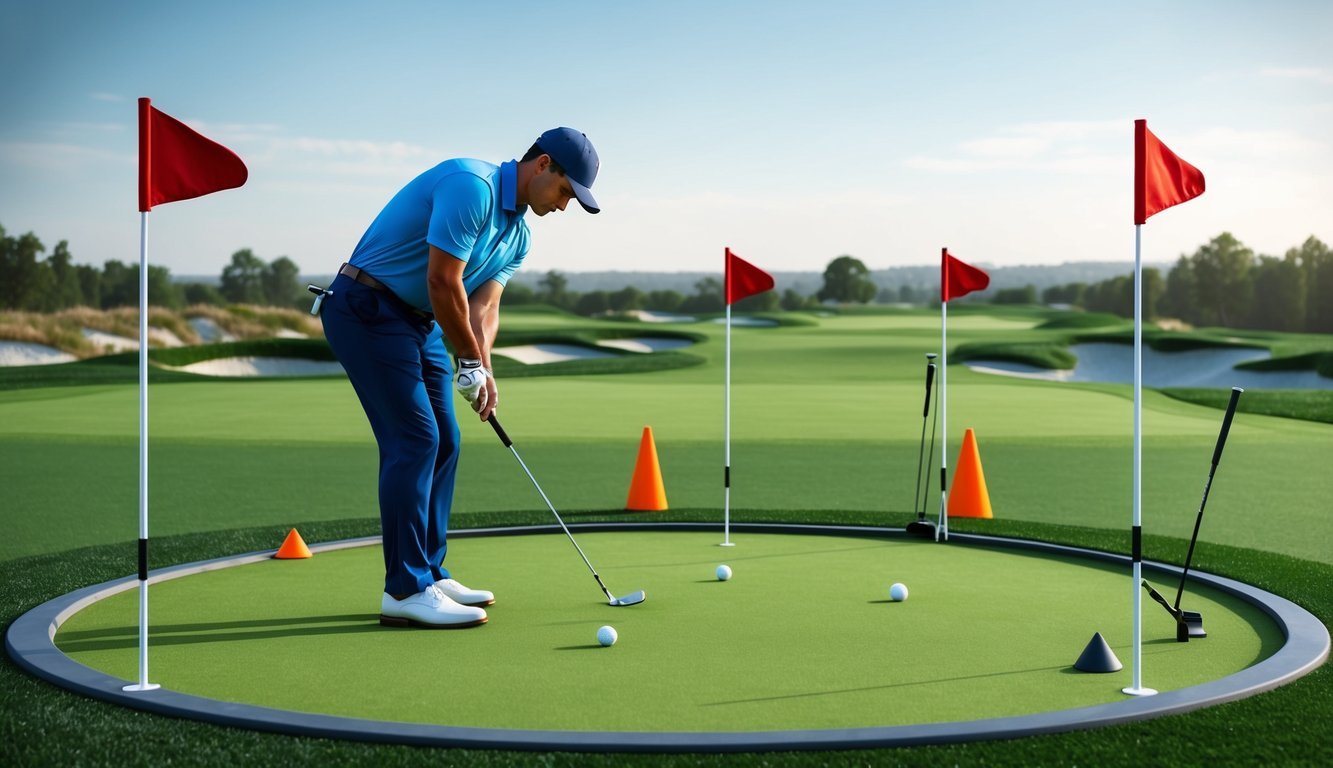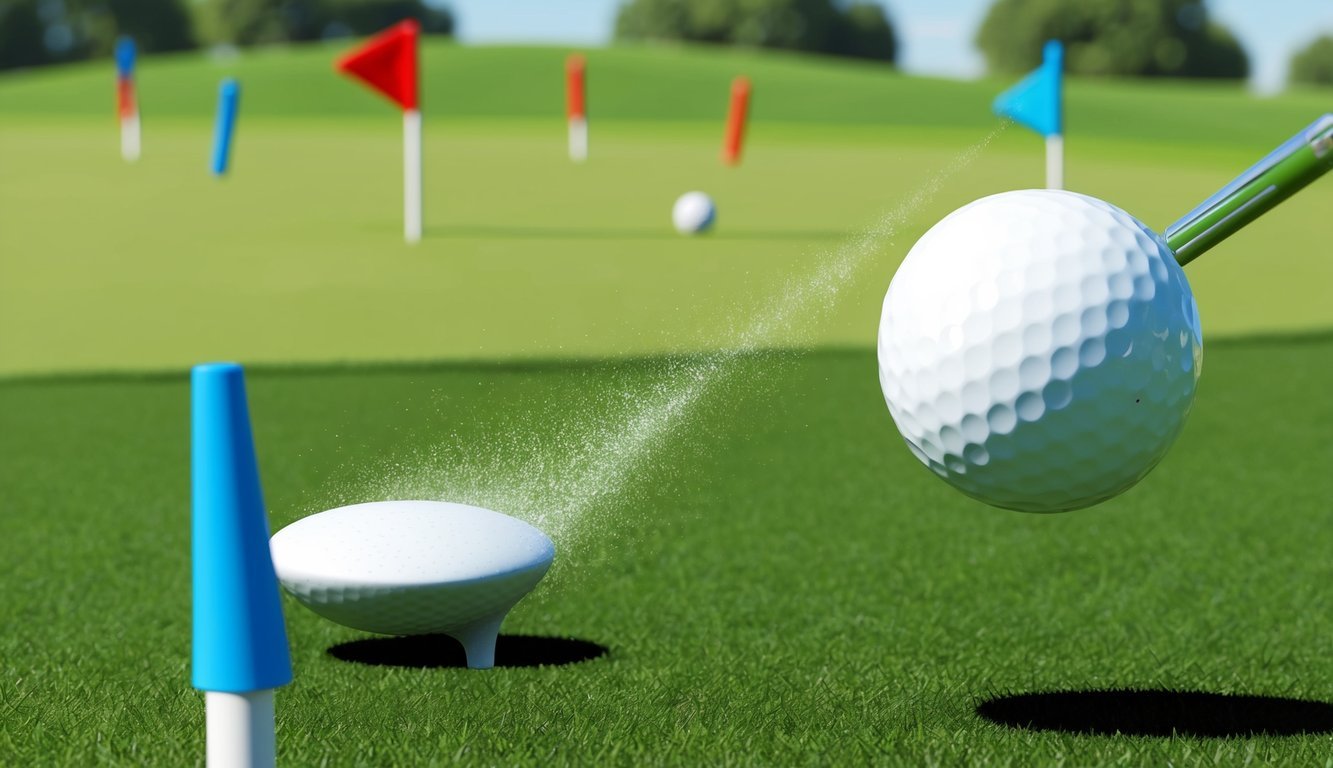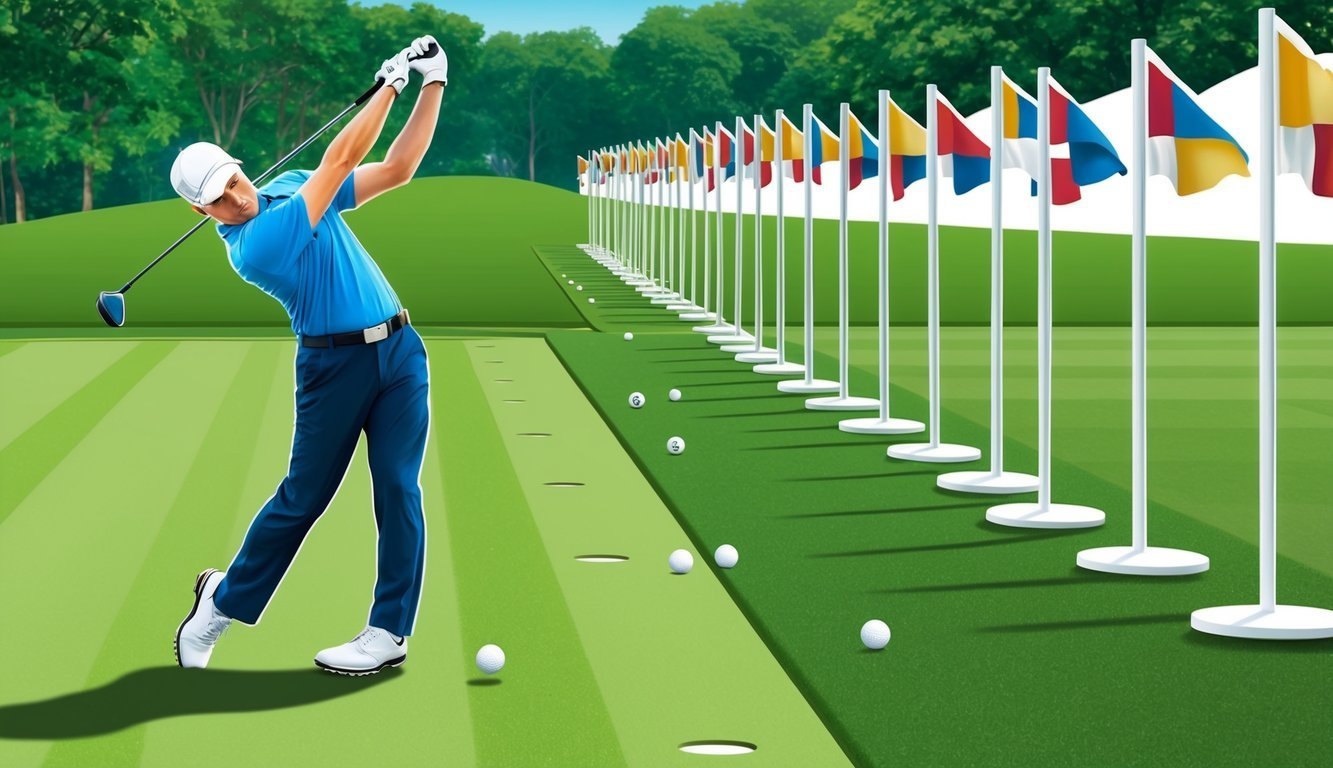If you’re looking to elevate your golf game, practicing effectively is key.
A well-structured golf practice routine can dramatically improve your performance on the course.
With the right drills and focus areas, you can maximize your progress, even if you don’t have hours to dedicate every day.

Understanding the essential components of a successful practice session helps tailor your approach to your individual skills and goals.
From refining your short game to mastering distance and accuracy, knowing how to balance these elements is crucial.
Embracing a mix of practice techniques not only refines your skills but also keeps your routine engaging.
As you embark on this journey, remember to be open to adjusting your practice plans and techniques.
Making conscious evaluations of your progress and recognizing what works best for you can lead to more enjoyable and fruitful play.
Key Takeaways
- A strategic practice routine enhances your golf skills.
- Balance focus between short game precision and accuracy.
- Regularly adjust your plan for optimal improvement.
Starting Your Golf Practice Journey
Embarking on a golf practice journey requires understanding fundamental concepts and setting clear, achievable goals.
By focusing on these key areas, you can enhance your skills and enjoy the game more.
Understanding the Basics of Golf
Getting started with golf involves mastering the basics.
This means familiarizing yourself with the essential equipment such as clubs, balls, and tees.
Begin with something like the 7 iron, as it is typically easier for beginners to handle and is crucial for practicing your swing.
Routine is vital.
Establish a consistent practice schedule that balances time on the driving range with time on the putting green.
Focus on different aspects of the game like driving, chipping, and putting.
This approach helps you improve steadily across multiple skills.
It’s important to track your progress.
Keep a golf journal to note key insights about your swing, stances, and strategies.
Such records can provide invaluable feedback and guide future practice sessions.
Setting Effective Practice Goals
Creating effective practice goals is key to improvement.
Start by setting specific, measurable objectives such as hitting 7-out-of-10 fairways during practice.
This type of goal helps you focus and measure your progress clearly.
Consistency is crucial.
Train regularly to develop muscle memory and enhance your performance.
Dedication to a regular practice routine will build your confidence on the course.
Consider practicing with a partner or participating in friendly competitions.
Engaging with others can add a layer of motivation and challenge you to reach new heights.
Consistent dedication, along with thoughtfully set goals, will pave the way for steady improvement and deeper enjoyment of golf.
Developing Core Golf Skills

To excel in golf, focus on foundational elements like stance and grip, alongside refining your swing techniques.
Solidifying these core skills enhances your overall game, allowing for improved control and accuracy during each play.
Building a Solid Stance and Grip
A strong stance and proper grip are critical for consistent golf performance.
Begin by placing your feet shoulder-width apart, ensuring your weight is evenly distributed.
Your knees should be slightly bent, promoting a natural and comfortable posture.
Align your shoulders parallel to your target line for better ball flight control.
When gripping the club, maintain firm yet relaxed hands.
Use the interlocking grip, where your pinky finger interlocks with the index finger of the opposite hand, or the overlapping grip.
Both methods support better club control and stability.
Adjust your grip pressure to avoid tension, which helps improve your swing path and balance during execution.
Align your clubface square to the target for optimal accuracy.
Mastering Golf Swing Techniques
Perfecting your swing is essential for enhanced performance.
Focus on mechanics by engaging your core muscles to generate power, then allow your arms to follow through naturally.
This sequencing ensures that your swing path is smooth and efficient, essential for consistent ball flight.
Ensure your body remains balanced and stable throughout the swing.
Keep your lead arm straight while allowing your trailing arm to bend slightly.
Incorporate a slight hip rotation for additional leverage.
Your follow-through should display a graceful arc that reflects proper mechanics.
Maintain your head position to improve alignment and ensure consistent contact with the ball.
With time and practice, these techniques can significantly elevate your game.
Creating a Practice Plan
Establishing a structured and balanced golf practice routine is crucial for improving your skills.
By organizing your time effectively and incorporating a variety of drills, you’ll make every hour of practice not just productive but enjoyable.
Structuring Your Practice Time
Organize your practice routine by dividing your time into focused segments.
Allocate specific durations for different aspects of your golf game.
For instance, dedicate 20 minutes to work on your full swing, allowing you to focus on consistency and control.
Spend 10 minutes on short game techniques, such as chipping and pitching, which are essential for lowering scores.
Consider using a digital or physical calendar to schedule regular sessions.
By committing to a structured plan, you’ll be able to track your progress over time.
Additionally, ensure you include breaks to maintain concentration and prevent fatigue. Variety is key to keeping your sessions engaging and effective, so mix up your practice areas regularly.
Incorporating Drills into Practice Sessions
Including drills in your practice plan helps in targeting specific skills.
Start with warm-up drills, such as the 7 Iron Sweep Drill, which can improve your swing plane.
This ensures you’re effectively working on the fundamentals before advancing to more complex areas.
Choose drills that challenge different facets of your game.
For example, use the Towel Drill to enhance ball striking accuracy.
Allocate time for practicing with different clubs, from wedges to woods, to build versatility.
Rotating drills ensures you don’t overwork a single area and keeps your sessions fresh.
Incorporate feedback into your routine by journaling your experiences and outcomes.
A progress journal helps identify areas needing improvement and celebrates achievements, keeping you motivated.
Enhancing Short Game Precision

Improving your short game precision involves honing the technical skills necessary for accurate chipping, pitching, and putting.
Focused short game practice can significantly improve your touch and control, helping you lower your scores.
Sharpening Your Chipping and Pitching
To enhance your chipping and pitching, focusing on technique and equipment is crucial.
Using the appropriate wedges for different distances and shots can dramatically improve your control.
Opt for a sand wedge for bunkers and a lob wedge for shorter, elevated shots.
Practice with targets in mind to simulate real-game scenarios, aiming for defined areas on the green.
Engage in drills that develop your precision and touch.
One effective drill is setting up a small target, such as a hula hoop, and practicing landing your ball within its boundaries.
This helps in developing muscle memory for distance control.
Perfecting Your Putting
Putting precision starts with developing a smooth and consistent stroke.
Use putting drills focused on controlling speed and direction.
Set up short targets and practice hitting them consistently without focusing too much on the hole initially.
A key technique involves practicing with short putts to build confidence.
You can enhance your skill development by refining your grip and stance, ensuring your body alignment is consistent.
Tracking your progress by recording your putts per round can also highlight areas for improvement and show tangible advancements in your putting skills.
Practicing for Distance and Accuracy

In golf, achieving distance and accuracy requires practice and the right techniques.
Whether you’re hitting drives off the tee or honing iron shots on the fairway, focusing on control and precision can significantly lower your scores.
Driving Range Routines
To improve your distance and accuracy with the driver, focus on full swings at the driving range.
Begin with a warm-up using a shorter club before progressing to the driver.
Practice hitting drives off the tee, aiming for a specific target to enhance your precision.
Incorporating drills like the 9-Shot Drill can help improve your ball-striking skills.
This involves varying the trajectory and shape of your shots, which enhances control.
For more tips on this effective routine, check out the Nick Foy Golf practice drills article.
Iron Shots and Fairway Skills
When working on iron shots, start with mid-irons to build confidence and then progress to longer irons.
Focus on maintaining a consistent swing plane to ensure you strike the ball cleanly.
One practical approach includes the 7 Iron Sweep Drill, which helps you perfect sweeping the ball off the tee.
Focusing on accuracy, simulate fairway conditions by selecting targets at different distances and controlling the ball’s trajectory and spin.
For more insights into effective iron practice, you can explore Golf Practice Guides, which provides comprehensive routines.
Prioritize distance control to master the ability to land your ball close to the desired target.
Evaluating and Adjusting Your Play

Improving your golf game involves recognizing your strengths and addressing weaknesses.
By refining your course management and focusing on specific areas like rhythm and tempo, you can make informed decisions to lower your scores during a round of golf.
Assessing Strengths and Weaknesses
Start by keeping a golf journal to detail each round you play.
Track areas where you excel, like hitting a consistent fade or maintaining rhythm.
Note weaknesses too, such as poor tempo or missing fairways.
Regularly reviewing this data helps identify trends and patterns in your play.
Additionally, consider getting feedback from a coach or using technology like swing analysis apps.
These tools can highlight weaknesses that might not be obvious during a game.
Watching recordings of your swing can also be insightful, providing a clear visual of areas for improvement.
Set specific goals such as increasing fairway accuracy by 10%.
Measure progress in each area, adjusting practice routines based on the results.
This structured approach enables you to focus on developing weaker aspects while maximizing your strengths.
Strategizing for Lower Scores
Lowering your scores involves more than just improving your swing.
It’s about smart course management.
Begin with a plan for each hole based on your strengths and weaknesses.
If you know your tempo falters under pressure, practice maintaining composure when approaching challenging holes.
Adopt strategies that play to your strengths.
For example, if you have a reliable fade, incorporate it into your shot selection to navigate tricky sections of the course.
Be mindful of your rhythm, adjusting it to match the flow of the game.
Actively adjust your approach as needed.
If a hole isn’t going as planned, alter your strategy on the fly to avoid compounding errors.
Focus on maintaining a consistent level of play.
Gradually refine your techniques to consistently achieve lower scores.

